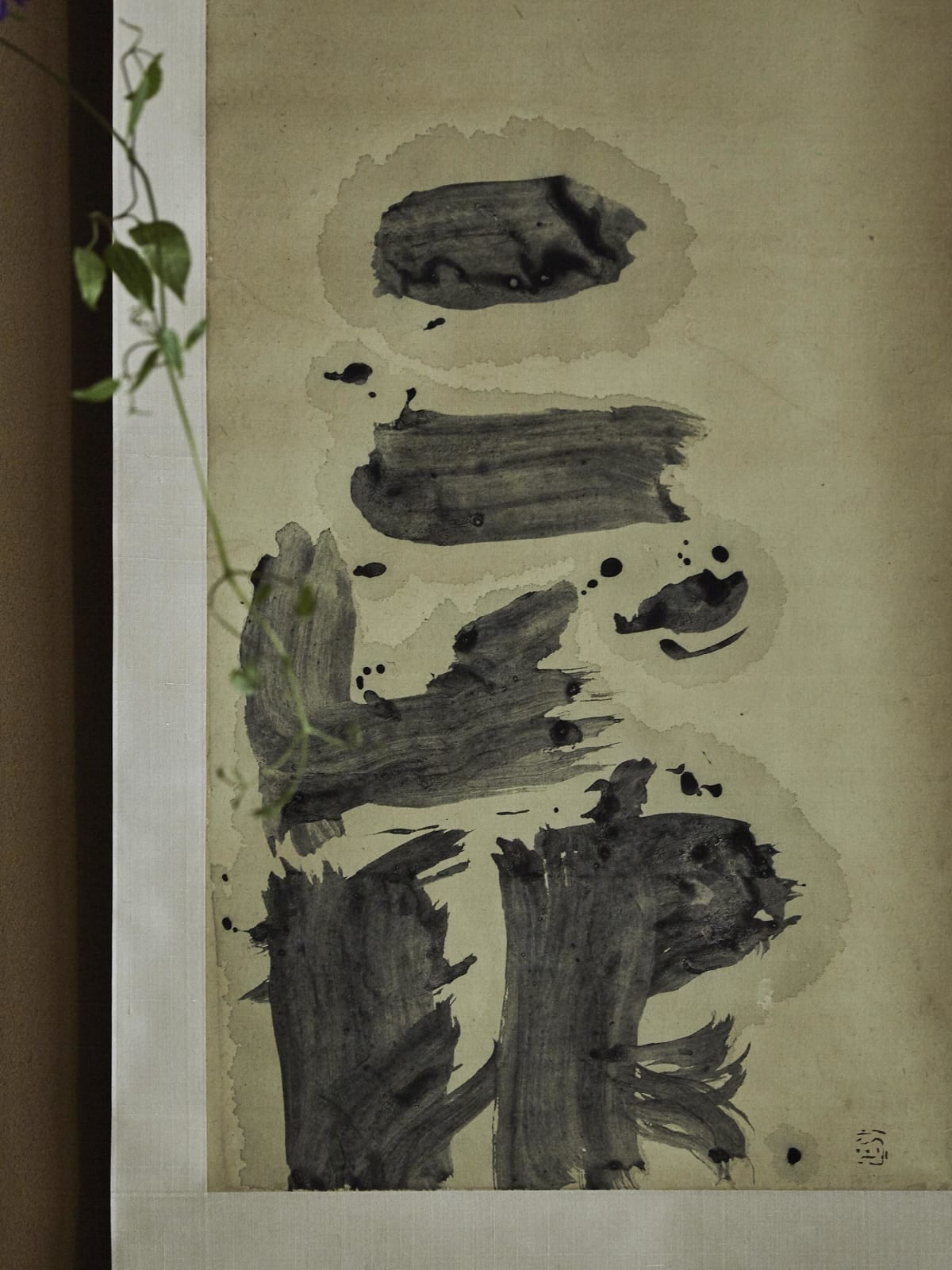Inoue Yūichi (1916–1985)
Ippiki ōkami (Lone wolf)
Ink on paper, hanging scroll
With box authentication by Unagami Masaomi
Seal: Yu
102 x 53 cm
167 x 67 cm (overall)
With box authentication by Unagami Masaomi
Seal: Yu
102 x 53 cm
167 x 67 cm (overall)
Further images
Exhibitions
’94 First-time Showing 35. Tokyo: UNAC Salon, 1994.Literature
Unagami Masaomi, ed. YU-ICHI [Yu-ichi INOUE] catalogue raisonné of the works 1949–1985. Vol. 2. Tokyo: UNAC TOKYO, 2000.
Ippiki okami (literally, “a lone wolf”) series made its first appearance in 1968. Ever since, only twenty-four pieces of works were executed: twenty pieces, including the present work, were produced in 1970 and the last four in 1978. In 1970, Inoue Yuichi was in deep solitude for he had serious conflicts with Morita Shiryu, the co-founder of Bokujin-kai group as well as his comrade of an avant-garde movement that rejected the worn-out tradition since 1952. He wrote the same series again in 1978; it was the year before he was diagnosed as having cirrhosis of the liver, which was the cause finally leading him to death.
By the end of 1960s more and more discontent with Shiryu concerning the future direction of their calligraphy, Yuichi faced a crucial moment in 1970 of either to follow Shiryu’s gradual transition in the latter half of the 1960s—returning to the tradition and learning from the classics, or to stand firmly on his ground—unfetteredly pursuing the inner self through impulse and sensation. Yuichi chose the latter. Two roads were diverged in front of Yuichi; he compared himself to a wolf, or a maverick, taking the unknown path and fighting in a lone battle till his death in 1985. Ippiki okami denoted Yuichi’s determined will, which was vowed in 1952 at Ryoan-ji Temple, Kyoto—in the ideal world of artmaking, people create art not for being positioned in the hierarchy of tradition, but for the sake of their own self.
Inoue Yuichi (calligrapher; 1916–1985)
Tokyo-born calligrapher. Studied calligraphy under Ueda Sokyu. Co-founded the avant-garde calligraphers group Bokujin-kai (Ink people society). His large scale, experimental calligraphy works of single Chinese characters responded to the concurrent international Abstract Expressionism, and breathed new life into the calligraphy world. Regarded as daring and innovative, his works were widely exhibited in Japan and abroad, including the Documenta in Kassel and the São Paulo Biennial.
By the end of 1960s more and more discontent with Shiryu concerning the future direction of their calligraphy, Yuichi faced a crucial moment in 1970 of either to follow Shiryu’s gradual transition in the latter half of the 1960s—returning to the tradition and learning from the classics, or to stand firmly on his ground—unfetteredly pursuing the inner self through impulse and sensation. Yuichi chose the latter. Two roads were diverged in front of Yuichi; he compared himself to a wolf, or a maverick, taking the unknown path and fighting in a lone battle till his death in 1985. Ippiki okami denoted Yuichi’s determined will, which was vowed in 1952 at Ryoan-ji Temple, Kyoto—in the ideal world of artmaking, people create art not for being positioned in the hierarchy of tradition, but for the sake of their own self.
Inoue Yuichi (calligrapher; 1916–1985)
Tokyo-born calligrapher. Studied calligraphy under Ueda Sokyu. Co-founded the avant-garde calligraphers group Bokujin-kai (Ink people society). His large scale, experimental calligraphy works of single Chinese characters responded to the concurrent international Abstract Expressionism, and breathed new life into the calligraphy world. Regarded as daring and innovative, his works were widely exhibited in Japan and abroad, including the Documenta in Kassel and the São Paulo Biennial.









